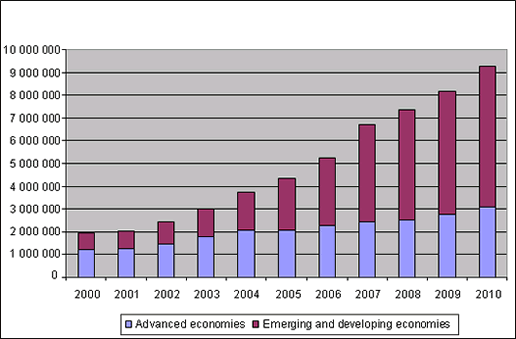1% of sovereign wealth fund assets from developing countries can lead to significant increase in development finance for Least Developed Countries
| EMBARGO The contents of this press release and the related Report must not be quoted or summarized in the print, broadcast or electronic media before 17 November 2011,17:00 [GMT] (12:00 New York; 18:00 Geneva, 22:30 New Delhi, 02:00 - 18 November Tokyo) |
Geneva, 17 November 2011 - Channelling only a tiny part - 1% - of the $3.5 trillion of foreign exchange reserves held by developing countries in their sovereign wealth funds to least developed countries (LDCs) can lead to a significant increase in development finance for these countries, claims the Least Developed Countries Report 2011 (LDC 2011)(1), a leading UNCTAD publication.
The report, released today, is subtitled "The Potential Role of South-South Cooperation for Inclusive and Sustainable Development".
This new proposal for increased South-South financial cooperation builds on the fact that using surplus financial resources from dynamic, emerging developing countries to fund development-oriented investment in LDCs can serve to build productive capacities, facilitate trade and support sustainable development. In addition to increasing access to financing for LDCs, such investments would provide sovereign wealth funds with an opportunity to further diversify their portfolios.
Given the declining prospects for increases in official development assistance from industrial countries facing fiscal austerity and possible limits for private flows due to the crisis, access to new forms of development finance is especially critical for building inclusive development paths in LDCs. A very fragile global recovery and highly constrained international liquidity conditions call for the creation of major financial mechanisms that could enhance the lending capacity of institutions such as regional development banks. These banks can be significantly expanded to provide low interest loans to LDCs as an essential instrument to facilitate their development strategies.
In this context, UNCTAD is proposing that developing countries with sovereign wealth funds invest 1% of their assets in regional development banks, for example in the form of increased paid-in capital. This should be done on a voluntary basis. Generally, regional development banks have performed very well in providing effective development financing, but they require additional resources to fund crucial investments, and this approach could prove to be an optimal vehicle for channelling resources to LDCs. It could facilitate intensified regional infrastructure investment that can promote trade and provide finance for green technologies. The financial details must be drawn up on a regional basis. Lenders and recipients should agree jointly on precise mechanisms and levels.
Regional development banks, such as the Asian Development Bank, for example, are already playing a key role in facilitating regional economic integration. In Latin America, some countries have also established subregional banks, such as the Latin American Development Bank, or CAF, which is considered to be very successful. Greater involvement of the regional banks will enable a greater sense of regional ownership and control of development projects. Regional or subregional development banks often rely on informal peer pressure rather than imposing conditionality. This allows them to disburse resources in a more timely and flexible fashion. They also tend to better reflect the experiences of successful developing countries.
Although LDCs have very limited power to negotiate with large global institutions, their voice can be amplified by regional or subregional development banks. Information asymmetries may be far smaller at the regional level. Therefore, regional public institutions may be well placed to provide regional public goods, especially those requiring large initial investments and regional coordination mechanisms. Good examples include financing regional infrastructure and coordinating the financing of region-wide projects in areas such as technological innovation. Another important function of regional and subregional development banks is financing small and medium-sized enterprises.
Financial sectors in most LDCs are mostly unable to fulfil these financing functions, as they remain shallow, underdeveloped and vulnerable to external shocks. In addition, the high level of indebtedness and dependence on foreign capital inflows means that LDCs are exceptionally exposed to external shocks.
The relative role and weight of regional banks is likely to increase, compared with that of traditional international financial institutions. These changes are expected to enhance the reciprocal trust between the bank and its beneficiaries, decrease the presently excessive role of conditionalities and streamline the efficiency of development-oriented lending operations in LDCs.
Between December 2001 and the end of 2010, the value of global reserves increased from $2.05 trillion to $9.30 trillion. The bulk ($6.1 trillion, or 80%) of the increase in global reserves in 2001-2010 was due to reserves accumulated by developing countries. A sizeable share of developing countries´ foreign exchange reserves have been accumulated in sovereign wealth funds, which are generally run independently from traditional reserve management by central banks and/or finance ministries. The total assets of these funds are estimated to be valued at $4.3 trillion, $3.5 trillion of which are held by developing economies.
However, the Report cautions that emerging possibilities for promoting South-South financing cooperation should be seen as a complement - not a substitute - to traditional official development assistance. The new opportunities for South-South cooperation will only work if they are additional to, not a substitute for, traditional North-South development cooperation.
ANNEX
Tables and figures
Chart 1 - World total foreign exchange holdings (Millions of dollars)
Source: UNCTAD, Least Developed Countries Report 2011


